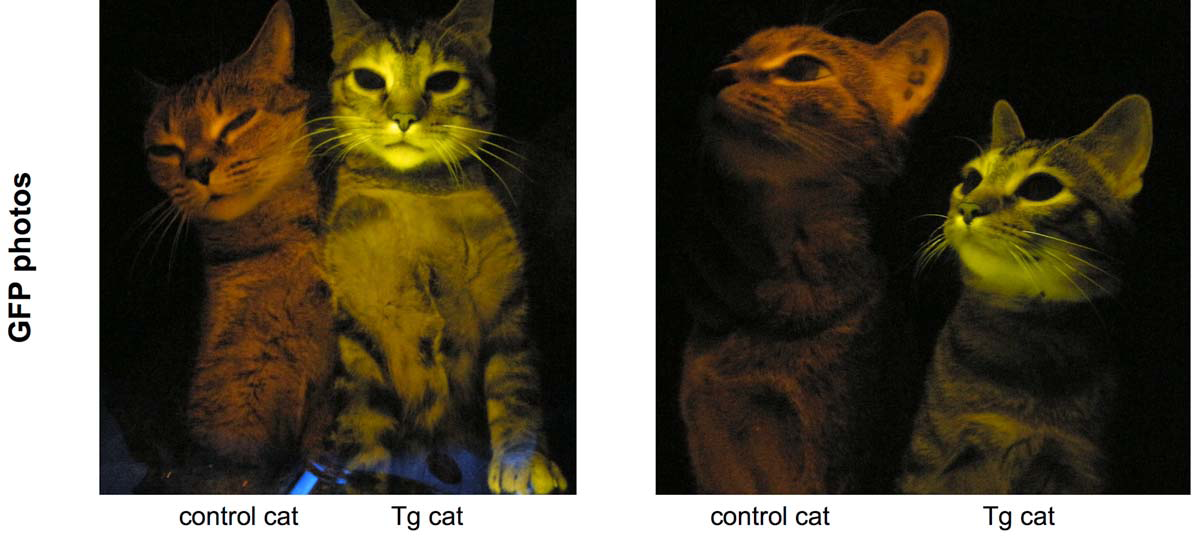No kidding. Researchers have genetically engineered cats to “carry a protein that defends them from infection by the feline immunodeficiency virus (FIV). The cats glow because a jellyfish gene was inserted as well as the FIV-resistant gene.
From Discovery.com “One of the best things about this biomedical research is that it is aimed at benefiting both human and feline health,” says Eric Poeschla, molecular biologist at the Mayo Clinic and lead author of the study published in Nature Methods.
The gene that protected the transgenic tabbies from FIV was originally from a type of monkey, the rhesus macaque. Since cross-breeding a cat and a monkey was impossible (not to mention even weirder and creepier than a glowing cat) the scientists had to use genetic engineering to put the rhesus’ genetic pieces into the cats.
They used a technique known as gamete-targeted lentiviral transgenesis. The tongue-twister technique involved inserting the desired gene into the cat’s eggs before sperm fertilization.
The resulting kittens produced the macaque’s protein, a restriction factor known as TRIMCyp, as well as the jellyfish’s glow in the dark chemical, known as green fluorescent protein.
Though this technique is not a direct treatment for FIV, HIV, or AIDS, it will help researchers understand how the proteins known as restriction factors can be used in gene therapy. Since FIV is similar to HIV, the luminescent cats could shed light on treatments for both diseases.”
From the published article on Nature Methods…
Abstract
“Studies of the domestic cat have contributed to many scientific advances, including the present understanding of the mammalian cerebral cortex. A practical capability for cat transgenesis is needed to realize the distinctive potential of research on this neurobehaviorally complex, accessible species for advancing human and feline health. For example, humans and cats are afflicted with pandemic AIDS lentiviruses that are susceptible to species-specific restriction factors. Here we introduced genes encoding such a factor, rhesus macaque TRIMCyp, and eGFP, into the cat germline. The method establishes gamete-targeted transgenesis for the first time in a carnivore. We observed uniformly transgenic outcomes, widespread expression, no mosaicism and no F1 silencing. TRIMCyp transgenic cat lymphocytes resisted feline immunodeficiency virus replication. This capability to experimentally manipulate the genome of an AIDS-susceptible species can be used to test the potential of restriction factors for HIV gene therapy and to build models of other infectious and noninfectious diseases.”
To see more pictures and read the supplemental information from Nature Methods, Click Here
Wishing you and your pet(s) the best,
Susan Thixton
Pet Food Safety Advocate
Author, Buyer Beware
Co-Author Dinner PAWsible
TruthaboutPetFood.com
PetsumerReport.com
What’s in Your Pet’s Food?
Is your dog or cat eating risk ingredients? Chinese imports? Petsumer Report tells the ‘rest of the story’ on over 2500 cat foods, dog foods, and pet treats. 30 Day Satisfaction Guarantee. www.PetsumerReport.com
Are you subscribed to Truth About Pet Food Newsletter? Click Here to subscribe
Follow Truth about Pet Food on Twitter
Become a Fan of Truth about Pet Food, Dinner PAWsible, Buyer Beware on Facebook
Find Healthy Pet Foods in Your Area Click Here



























